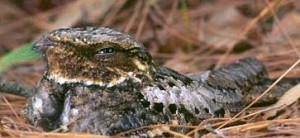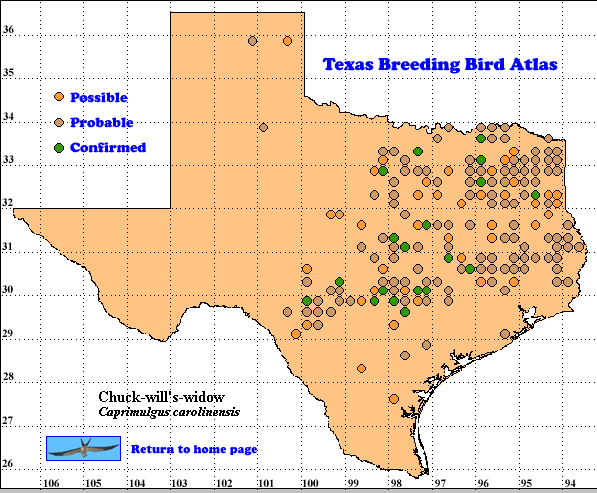The Chuck-will’s-widow is the largest nightjar in North America. Its name comes from its distinctive call, an emphatic chuck will’s widow with an accent on the third syllable. Non-birdwatchers often misidentify this bird as its more famous cousin, the Whip-poor-will. The Chuck breeds in the southeastern United States and winters in Central America, Columbia, and the Greater Antilles. A few individuals may winter along the U.S. Gulf Coast (Oberholser 1974).
Chuck-will’s-widows migrate in Texas from late March through early May and will initiate breeding soon after arriving on their breeding grounds. Nests with eggs are possible as early as 4 April (Oberholser 1974). Thus, atlasers had to use caution when assigning breeding status to birds found in April and early May.
DISTRIBUTION: The Chuck-will’s-widow is common as a breeding bird in the eastern third of Texas and along the southern edge of the Edwards Plateau. It inhabits mixed woodlands with pine in the east and junipers along the Edwards Plateau. It is rare along the Canadian River (35101-GH12 and 35100-H3) in the Panhandle and along the Caprock Escarpment (33100) on the southern edge of the High Plains. In these areas, it is associated with mixed woodlands along watercourses and canyons.
SEASONAL OCCURRENCE: The Chuck-will’s-widow is a difficult species to confirm. Out of 288 total TBBAP records, only 20 records (7%) represent confirmed status. Nesting birds rely on their cryptic plumage for camouflage and are reluctant to flush when approached by an observer, making their nests difficult to locate. Of the confirmed records, half are for nests with eggs. The eggs are creamy colored and, although they may have some darker markings, tend to stand out from the nesting substrate. Young are covered in a tawny-colored down (Bent 1940) and are less easy to locate.
The easiest way for an atlaser to determine the presence of Chuck-will’s-widows is by their vocal activity. They are difficult to overlook if an area is surveyed at the proper time and season. Chucks often call before dusk (Grant 1993) and call more frequently at night when the moon is more than half full compared to less than half full (Cooper 1981).
Bent (1940) reports egg dates for Texas from 4 April to 16 June. TBBAP data document late egg dates, with a clutch found on 20 June in latilong 29097, quad H8, and another on 8 July in latilong 30097, quad A2.
BREEDING HABITAT: Chuck-will’s-widows typically nest in woodlands, either coniferous, deciduous, or mixed, but they may nest in brushy areas on rocky or sandy slopes (Oberholser 1974). At night, they forage along woodland edges and over adjacent open areas, such as pasture land. Cooper (1981) found them showing a relative affinity for open habitats associated with pastures.
Nests consist of two eggs laid on the ground upon a carpet of dead leaves. No material is added to the nest. Typically, nests are in areas with little or no underbrush. Chucks show high site fidelity from one year to the next and will nest within 3 m of previous nest sites (Bent 1940).
STATUS: The Chuck-will’s-widow’s status in Texas remains uncertain, but it seems to be holding its own. The three TBBAP records in the Panhandle indicate the bird may be more widespread there than previously thought. These populations could have been missed previously because of the nocturnal habits of these birds. Oberholser (1974) does not show any records for the Panhandle, while the Texas Ornithological Society checklist (TOS 1995) lists the bird as uncommon in Hutchinson County. TBBAP records are from Dickens (33100) , Hemphill (35100), Hutchinson (35101), and Motley (33100) Counties. Two of these three records do not appear to be of migrants. Oberholser (1974) lists the late date for spring migrants as 19 May. Multiple singing males were found on 18-19 June in Hutchinson County. A local rancher reported these birds are present every summer. For Dickens/Motley counties, three singing individuals were encountered on 27 May. If these were migrants, they would represent new late migration dates; however, with the presence of three individuals, the likelihood is that these were breeding birds. No date was available for the Hemphill County record.
Along the coastal plain, TBBAP data show fewer records than expected from Oberholser (1974) or the TOS Checklist (1994). One record, latilong 27097 quad E8, is from 3 May and may represent a migrant. Local checklists show Chuck-will’s-widows to be uncommon to common migrants (for example, LaVern & Jones 1989) and only occasional nesters (Dauphin et al. 1989).
North American Breeding Bird Survey (BBS) data (Sauer et al. 1995) show a slight, but not significant, decline in Texas since 1966. BBS data do show a significant decline in the eastern United States, while in the central United States, Chucks do not appear to be declining. Thus, the Chuck-will’s-widow’s status in Texas remains uncertain based on a slight decline in BBS data and less common occurrence along the coast, while appearing to be more widespread in the Panhandle than previously thought.
Text by Cade L. Coldren (ca. 1996)
Literature Cited
Bent, A .C. 1940. Life histories of North American cuckoos, goatsuckers, hummingbirds, and their allies. U.S. Nat. Mus. Bull. No. 176.
Cooper, R .J. 1981. Relative abundance of Georgia caprimulgids based on call-counts. Wilson Bull. 93: 363-371.
Dauphin, D .T., A. N. Pettingell, and E .R. Rozenburg, Compilers. 1989. A birder’s checklist of the upper Texas coast, 7th ed. Ornithology Group, Houston Outdoor Nature Club.
Grant, G. S. 1993. Onset of evening calling by Chuck-will’s-Widow. Chat 57: 72-75.
LaVern, G., and D. Jones, Compilers. 1989. Birds of Brazos Bend State Park and adjacent areas: A field checklist. Res. Manage. Sec., Texas Parks Wildl. Dept., Austin.
Oberholser, H.C. 1974. The bird life of Texas. University of Texas Press, Austin.
Sauer, J. R., B. G. Peterjohn, S. Schwartz, and J. E. Hines. 1995. The North American Breeding Bird Survey Home Page. Version 95.1. Patuxent Wildlife Research Center, Laurel, MD.
Texas Ornithological Society. 1994. Checklist of the birds of Texas, 3rd ed. Austin.

